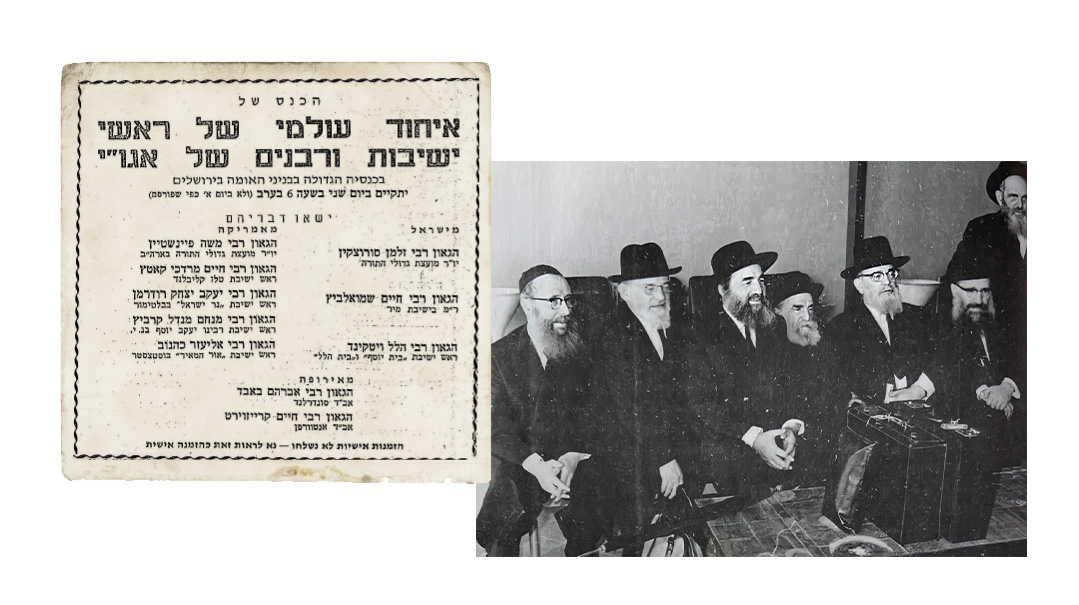From Shanghai to Seagate
| May 24, 2022Rav Mendel Kravitz (Krawiec 1907–1992) was undoubtedly one of the postwar builders of Torah

Title: From Shanghai to Seagate
Location: Jerusalem
Document: Hamodia
Time: July 1964
The fifth Knessiah of the World Agudas Yisrael, a historic event, was to be held at Jerusalem’s impressive and relatively new Binyanei Ha’umah. The American delegation included a rosh yeshivah who, according to one keen observer, hadn’t taken his eyes out of a sefer the entire 12-hour flight.
His journey until that point had spanned the familiar milieu of the yeshivos of prewar Poland, a tumultuous sojourn in Shanghai, and finally his tenure as rosh yeshivah in RJJ. Though he traveled through time and space, his home remained the four walls of the beis medrash. This was Rav Menachem Mendel Kravitz.
Rav Mendel Kravitz (Krawiec 1907–1992) was undoubtedly one of the postwar builders of Torah. His connection to Rav Aharon Kotler dated back to his time in Slutzk and Kletzk. Rav Aharon appointed him chozer of his shiurim, as Rav Mendel was one of the few who fully comprehended their depth. Rav Mendel also merited a closeness with his rebbi’s father-in-law, Rav Isser Zalman Meltzer, and Rav Aharon also asked him to study with his son Rav Shneur.
Rav Mendel’s nearly two decades there were interrupted when Rav Aharon made an extended fundraising trip to the United States in 1936. Rav Elazar Menachem Shach knew Rav Mendel from Kletzk, and advised him to utilize Rav Aharon’s absence to imbibe the Torah of Rav Yitzchak Zev Soloveitchik, the Brisker Rav. Rav Mendel subsequently remained in Brisk for two years.
When the Kletzk yeshivah relocated to Vilna in the early stages of the war, Rav Mendel was recommended as a shidduch to Rashel Berek, daughter of Rav Aharon Berek, the secretary of the Vaad Hayeshivos. Their engagement was soon overtaken by world events, and Rav Mendel and his fiancée were forced to flee to Shanghai, China. The situation stabilized after two years, and they got married in 1942 in Shanghai. They then immigrated to the United States in 1946, where they settled in a basement apartment in Seagate, at the edge of Brooklyn.
Due to Rav Aharon Kotler’s influence, Rav Mendel was appointed rosh yeshivah of RJJ on the Lower East Side in 1948. His schedule included delivering a daily blatt shiur and the semichah shiur, where he readied scores of budding scholars for the rabbinate. Rav Mendel didn’t have his own honor in mind, however, nor the prestige of the institution that employed him. Concerned only for the Torah advancement of his talmidim, he sent the best and brightest to study in Lakewood as students of his own rebbi, Rav Aharon Kotler. This included some of the greatest roshei yeshivah of the subsequent generation — Rav Meir Hershkowitz, Rav Moshe Hillel Hirsch, Rav Levi Dicker, Rav Meir Stern, Rav Yisrael Meir Kagan, Rav Yitzchak Wasserman, and others.
With the neighborhood changing on the East Side, he retired in 1973 and moved to Israel. He renewed his close friendship with Rav Berel Soloveitchik, and Rav Shach recommended him to deliver a shiur at the Karlin Yeshivah in Yerushalayim. His deteriorating health compelled him to return, and he lived out his final years in Florida, where he delivered regular shiurim in the Crown Hotel.
A Litvishe Rebbe
The chassidim in Seagate were drawn to this litvish talmid chacham. In 1959 he opened his own shul in Seagate and had a great impact on the year-round community, as well as on the summer vacationer crowd, who were primarily chassidic. He even conducted a weekly Shalosh Seudos.
Bear any Burden
Rav Kravitz’s father-in-law, Rav Aharon Berek, was the dedicated secretary of the Vaad Hayeshivos, alongside its able administrator Rav Yosef Shub. The dire financial straits of the yeshivos in Poland led Rav Chaim Ozer Grodzenski and the Chofetz Chaim to establish this umbrella organization in 1924 to ease the financial burden. Rav Shub and Rav Berek were hired to oversee the day-to-day operations. Understaffed, underpaid, and overworked, these two heroic individuals carried the weight of an ever-increasing deficit and frantic calls for help with equanimity and integrity. Tragically, they and their families were all killed by the Nazis in the Vilna Ghetto.
(Originally featured in Mishpacha, Issue 912)
Oops! We could not locate your form.






